Museums and Exhibitions in New York City and Vicinity
| Home | | Museum Guide | | International | | Architecture & Design | | Theater |
GLENN LONEY'S MUSEUM NOTES
CONTENTS, December, 2001
[01] Holiday Traditions at Met
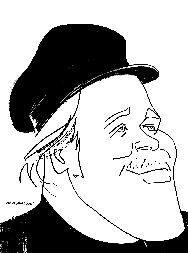
Caricature of Glenn Loney
by Sam Norkin.
[02] Extreme Beauty: Costume Transformations
[03] New Neue Galerie on Fifth Avenue
[04] New Asia Society Museum on Park
[05] Norman Rockwell at Guggenheim
[06] Jacob Lawrence at Whitney & Times Square Subway
[07] 19th Century Jewish Artists Emerge
[08] Ben Katchor's Picture-Stories at Jewish Museum
[09] Wonderful Watches & Clocks at Frick
[10] Klimt, Schiele, Kokoschka at St. Etienne
[11] Egyptian Treasures from London in Brooklyn
[12] Powerful Photos of 100 Endangered Sites
[13] Baseball Hall of Fame Coming to American Museum of Natural History
[14] Pairings of Matisse & Picasso Promised for MoMA QNS
You can use your browser's "find" function to skip to articles on any of these topics instead of scrolling down. Click the "FIND" button or drop down the "EDIT" menu and choose "FIND."
For editorial and commercial uses of the Glenn Loney INFOTOGRAPHY/ArtsArchive of international photo-images, contact THE EVERETT COLLECTION, 104 West 27th Street, NYC 10010. Phone: 212-255-8610/FAX: 212-255-8612.
Copyright © 2000 Glenn Loney.
For a selection of Glenn Loney's previous columns, click here.
Holiday Spectacles at New York Museums & Galleries—
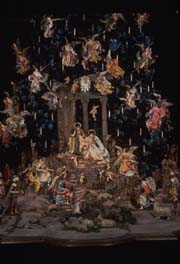
|
|
| BAROQUE NEAPOLITAN CHRISTMAS AT THE MET MUSEUM--The Nativity. | |
Tradition & Ostentation at the Met Museum:
The fabulously decorated Christmas Tree at the Metropolitan Museum for years has been as much a holiday tradition for New Yorkers as the great glittering forest-giant in Rockefeller Center.
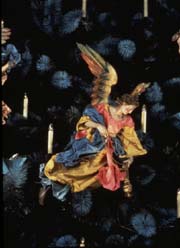
|
|
| BAROQUE NEAPOLITAN CHRISTMAS AT THE MET MUSEUM--Heaven-Sent Angel | |
The Met's tree, of course, is not alive. It is assembled from bits and pieces which are in storage the rest of the year. But it comes magically alive when hundreds of precious golden-winged angels and 18th century Neapolitan Christmas figures are hung from its branches and spread around its base.
This holiday season, for the first time, there will be Equal Time for at least one other Major Faith. An historic Menorah will also be on display. Unfortunately, this is not that fabled candelabra that Titus brought back to Rome from the Sack of Jerusalem.

|
|
| 18th CENTURY HANUKKAH MENORAH AT THE MET MUSEUM | |
The recently invented holiday festival of Kwanzaa will sure soon be accorded its own celebratory artifacts. African-Americans deserve no less, especially if Christmas is seen as a festival of their oppressors and former slave-holders.
Considering America's even more recent interest in Ramadan, Eid al-Fitr, and other Muslim holidays, the Met should be planning to become even more inclusive in its holiday salutes. After all, the US Postal Service issued a handsome Eid Stamp just days before the destruction of the World Trade Center!
EXTREME BEAUTY: The Body Transformed
Fabulous Couture from the Met's Costume Institute
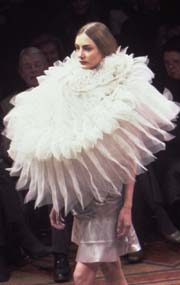
|
|
| HAVING A RUFF TIME!--Body Transformation at Met's Costume Institute | |
Even the grand panniered historicist gowns of John Galianos—for Dior Haute Couture—require bodies of great style and sleekness to show them to best advantage. Drag Queens would kill to don such arresting costumes.
Most of the contemporary transformative costumes on view at the Met are clearly designed for very stylish—and also very wealthy—women who can both wear them with panache and easily afford them.
Junya Watanabe's immense Techno Couture white ruff—designed for Comme des Garçons—engulfs the upper body, leaving a woman's head looking like a small fruit in a sea of frothy fabric.
Curator Harold Korda doesn't show this design-extravagance in isolation, however. Nearby are ruff-laden portraits of 16th century ladies—whose heads also seem somewhat separate from their overclad bodies.
There are such astonishing modern inventions as inflatable skirts. Want to keep people Out of Your Space? When you have pumped up the panels of one of these, no one can come within a yard of you.
Contemporary fashion-excesses are balanced by fads of former times, such as the bustle and the hoop-skirt. The range of bustles on view is amazing.
But there is one modern adaptation of body-padding which would make its owner look like a hunchback!
Deliberate body-deformations through costume are most painfully demonstrated by the collection of tiny Chinese embroidered shoes for women with Bound Feet.
Although in Nature the male is usually more gaudy than the female, in Fashion—and at the Met's Costume Institute—it's the female who wears the Fine Feathers.
Transformative costumes for men are few in this exhibition. Notable are the metal codpieces from medieval armors. And the grotesquely long gourd Penis-Sheaths from the South Pacific.
Korda has organized the exhibition into five sections: Neck & Shoulders, Chest, Waist, Hips, Feet. This leaves out head-transformations and glides down past the thighs and forelegs. But then they are usually covered up by skirts.
To accompany, interpret, and record this bizarre and often amusing show, Korda has provided a handsomely illustrated catalogue, published by the Met and distributed by Yale University Press. Bearing the show's title, it costs $40 hardcover and $25 in paper.
Saluting New Museums in Manhattan!
The Neue Galerie New York:

|
|
|
NEUE GALERIE ON FIFTH AVENUE--From Vanderbilts to Austrian Expressionists. |
|
Ronald Lauder Creates a New Landmark—
A Museum for German and Austrian Art
[Current show closing February 18, 2002]
In the splendid Beaux Arts Carrère & Hastings-designed palais on Fifth Avenue at East 86th Street, philanthropist/collector Ronald Lauder has recently and immensely enriched the city's arts culture. With the creation of Neue Galerie New York, he has paid tribute to the genius of Austrian & German Modernism & Expressionism, as well as to the vision of his fellow enthusiast, Serge Sabarsky. In fact, the charming Viennese Coffee-house on the first floor—with magnificent views of Central Park—is named for his fellow-admirer of Beckman, Schiele, Kokoschka, Klee, Kirchner, Kandinsky, & Klimt.
The noble chambers of this great mansion—once home to the YIVO Institute of Jewish Research—retain the feeling of the patrician elegance associated with an even earlier occupant: Mrs. Cornelius Vanderbilt.
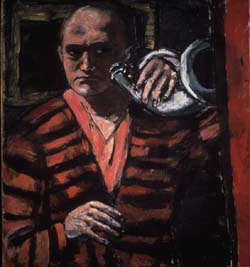
|
|
| ] MAX BECKMAN WITH A HORN--Neue Galerie Masterpiece of German Modernism | |
But architect Annabelle Selldorf has adapted the spaces for museum-display functions with minimum detraction from the handsome detailing. Seeing paintings by Klimt or Klee here is very much like viewing them in a baronial palace rather than in a museum-gallery.
In addition to the current displays of paintings and sketches, there are also a number of admirable objects from the studios of the Wiener Werkstätte. Some of the Jugendstil decorative arts designs and applied arts on display are as modern as today. Although designers like Kolo Moser and Josef Hoffmann created them a century ago!
The Neue Galerie's objective is to concentrate on early 20th century fine & decorative arts of Austria & Germany. Drawing on the collections of the Lauder Family and Serge Sabarsky, masterpieces will always be on view.
But twice a year there will also be special exhibitions. The gallery's functions include not only display, but also collection, preservation, and research into this fascinating area of Central European Modernity. [See also the note on Galerie St. Etienne's current show of Klimt, Schiele, and Kokoschka.]
The New Asia Society & Museum:
Inside Its Former Post-Modernist Park Avenue Shell

|
|
|
ANCIENT PRAYERS--Sixth Century statue in Asia Society Museum. |
|
But inside, Edward Larrabee Barnes' imposing building has been transformed by architect Barthlomew Voorsanger.
Most impressive are the grandly curving Post-Modernist flights of stairs. In fact, four levels of splendid stairways dominate the Park Avenue interior. They are constructed of blue laminated glass treads on a bold white steel structure.
But the reconformation has doubled the size of exhibition galleries and public spaces, as well as enhancing its conference, education, and performance spaces. Actual artifacts—ancient and modern—will vie with computer virtualities for the attention of visitors, notably of students who are Experts Online.
The ground-floor shop—with dazzling arts, crafts, and books—can be closed off with pivoting undulating translucent panels, suggesting shoji-screens gone surreal.

|
|
|
RIDING THE RIDDEN--Contemporary artwork by Shazia Sikander at Asia Society |
|
Nearby is a handsome new cafe-space, in a glass-walled sunlit atrium. This is a welcome trend in new galleries and museums, as at the Neue Galerie and Scandinavia House on Park Avenue South. Much more inviting than Starbucks any day!
One of the current exhibitions—Monks and Merchants: Silk Road Treasures from Northwest China, 4th-7th Century—could be styled "infinite riches in little room." This new gallery is so small it's almost claustrophobic.
The Creative Eye—selections from the fine collection of Mr. & Mrs. John D. Rockefeller 3rd—fortunately has a much larger gallery at its disposal.
On museum walls are contemporary artworks—two long hangings being especially impressive—by two South Asian women artists: Nilima Sheikh and Shahzia Sikander.
New & Current Exhibitions of Note:
NORMAN ROCKWELL:
Pictures for the American People
The Guggenheim Proves Itself Populist
As Well as Expressionist & Historicist
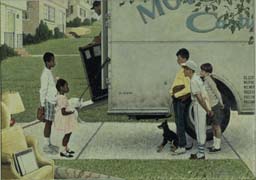
|
|
|
NEW KIDS IN THE NEIGHBOURHOOD in the Guggenheim. Photo: Guggenheim. |
|
As well as to extend its Modernist Hegemony beyond Manhattan to Berlin, Bilbao, St. Petersburg/Las Vegas, and possibly even to Salzburg? Peggy Guggenheim's Venice Museum, of course, was already in place before expansionism set in.
As an art museum dedicated to the various emergences & expressions of Modernism, it had long seemed a leader. And it drew on a powerful permanent collection as well.
But its recent colorful exhibition of Motor-Cycles—all of which did represent some phase of Modernism in design and decoration—caused some to doubt its mission: had it lost its way?
A planned Versace exhibition was even decried & denounced. Commercialism? The sound of one hand washing the other?
But the Guggenheim—at least as designed by Frank Lloyd Wright—has never been an ordinary museum. It is, in fact, itself a giant Modernist Sculpture, dominating its area and not really welcoming to exhibitions of paintings.
Its spiraling display-coves are much better suited to spatial arts, sculptures, and constructions. They are very good for a number of the historical arts-artifacts currently on display from Brazil.
And Wright's great glass-domed rotunda is ideal for the towering golden baroque church altar.
This is hardly to be compared with motor-cycles, being some two centuries older. But it also raises questions about the Guggenheim's current dedication. Is it still to Modernism? Or is it also about art-history, folk-art, or even ethnography?
Brazilian Indian blow-pipes and feathered cloaks combine art & ethnography, it's true.
But what about the artworks—or magazine-illustrations—of Norman Rockwell? What are they doing here—aside from the fact that this is just once stop on a national tour?
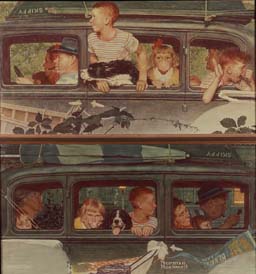
|
|
|
COMING AND GOING in the Guggenheim. |
|
Considering the fact that the American Museum of Natural History will soon be hosting a Baseball Hall of Fame Exhibition—justified as a form of cultural ethnography: American's National Sport, after all—Rockwell's pictures may well be a documentation of mid-20th Century American dreams and fantasies.
Studying the original Rockwell artwork and the actual Saturday Evening Post magazine-covers now on view at the Guggenheim, it seems more likely that Rockwell helped us give visible form our dreams and fantasies.
With an extra dollop of cuteness and sentimentality we could not have imagined ourselves. "Pop Corn" was the judgment of New York Magazine's critic.
Still, whether Rockwell was "only" a technically skilled illustrator, or an authentic and talented artist, his body of work is impressive. And a number of the images on display have over time become Icons of American Life.
So this is an exhibition which surely should be seen—and pondered from several points of view. N. C. Wyeth and Howard Pyle were also illustrators whose art transcended mere enhancement of magazine fictions.
German Expressionism—a Guggenheim speciality—is not for everyone. But everyone should visit Wright's Guggenheim. So why not schedule crowd-pleasers from time to time? Let the public and the light in!
In the sad wake of the September 11 World Trade Center Disaster, seeing all these wryly sentimental Rockwell visions of American Nostalgia can be both encouraging and entertaining.
OVER THE LINE:
The Art and Life of Jacob Lawrence
Thought-Provoking Major Retrospective
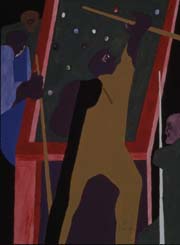
|
|
|
POCKET POOL--Colorful Jacob Lawrence picture in Whitney Retrospective. |
|
At Whitney Museum & Times Square Subway
[Closing February 3, 2002] Every day, hundreds of New Yorkers and tourists who are too busy to get up to the Whitney Museum to see the current Jacob Lawrence show have an easy opportunity to enjoy his last and most vibrant, joyous public commission. Absolutely free—with the prior use of a token or Metrocard…It is on view 24 hours a day in the newly renovated Times Square Subway Station. It's a glittering glass mosaic of New Yorkers on the go. It's aptly named "New York in Transit."
Although Lawrence died last year, he received the commission from the MTA in 1990. Even then plans were underway for redesigning the station and enhancing it with artworks.
The mosaic was created in 1997 and recently installed. It is bisected by a roof-support-column, so it cannot be easily viewed as a whole. But it is brilliantly illuminated. You don't need a flash to get a good photo of it.
Meanwhile at the Whitney, the many examples of Lawrence's vision of American Life—especially for African-Americans migrating North from the South—show a development which moves toward the exuberance of the Times Square mural.
Over the years, however—depicting or diffracting the tears and fears of American black citizens—Lawrence's color palette was considerably more somber than the glittering glass in the subway.
Notable among the pictures on display are selections from his Migration of the Negro Series, the War Series, and the History of the American People.
These are all very powerful images by an artist too little known to the American People during his lifetime. Now, perhaps, his work may reach a much wider—and more receptive—public.
Seen already in Washington, DC, the show will travel to Detroit, Los Angeles, and Houston. Do not miss it!
EMERGENCE OF JEWISH ARTISTS
IN 19th CENTURY EUROPE
Remarkable Portraits & Genre Scenes
At The Jewish Museum on Fifth Avenue
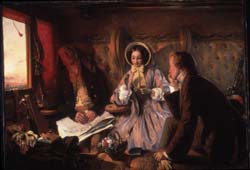
|
|
|
JEWISH ARTISTS EMERGE--Abraham Solomon's 19th century triumph of pictorial
story-telling, now at the Jewish Museum. |
|
The baronial chambers of its spacious second floor are currently home to some very impressive 19th century paintings which might well have looked entirely "in place" here a century ago.
After centuries of religious—as well as artistic—oppression—during which time Jewish artistic talents were largely confined to working with gold, silver, and jewels—the Enlightenment paved the way for their emergence into the wider worlds of art, previously open only to Christians.
Some extremely talented Jewish painters in the 19th century began to find their way into the elegant salons of the rich and powerful. Notably in Paris, but also in London and other major European capitals.
The paintings now on display range from sensitive portraiture, through subtle caricature, to grand academic canvases on Jewish and Christian religious themes. In fact, there is not a picture in this show which does not have a story to tell.
Many of these fine painters will be unknown to most viewers. But certainly Camille Pissarro and Max Liebermann are by now almost mainstreamers in modern art-history.
The Jewish Museum has just collaborated with the Dahesh Museum—located on Fifth Avenue midtown—on a panel on religious art. Major canvases with Biblical or ritual subjects are currently featured at both museums.
BEN KATCHOR: Picture-Stories

|
|
|
BEN KATCHOR'S "THE NEWSSTAND"--Serio-Comic-Strip sequence from
Metropolis magazine. |
|
Satire/Surrealism/Insight/Whimsy/Urban History
Cartoons & Comic-Strips On View at Jewish Museum
[Closing February 10, 2002]
You really should plan to spend an entire morning or afternoon on the ground-floor of the Jewish Museum. Not just to inspect the offerings in the bookstore. The main gallery is crammed with comic-strip panels drawn by Ben Katchor, one of the most gifted and imaginative social critics now seen in the alternative press. As well as in the Jewish Forward and the mainstream design-magazine Metropolis.
The reason you will want to spend some time studying the panel-sequences is not just because of Katchor's very special drawing style. He also has a mordant sense of humor about the Past, Present, and Future.
For Metropolis he offers each month a backpage color cartoon-story dealing with some appalling contemporary conceit in architecture or decoration. These are eminently collectible.
His serio-comic picture-book novels have also become Collectors' Items. Do you own a copy of Cheap Novelties: the Pleasures of Urban Decay? Or Julius Knipl, Real Estate Photographer, or The Jew of New York?
Most recently, Katchor was honored by the American Academy of Arts & Letters. But he had already won a Guggenheim and a MacArthur "Genius" Award. The comic-book opera, The Carbon Copy Building—with words and sets by Katchor—won an Obie Award.
If you don't have time to read and admire all the Katchor panel-sequences on view, at least buy one of his books to study at home. Or subscribe to Metropolis!
THE ART OF THE TIMEKEEPER:
Masterpieces from the Winthrop Edey Bequest
Intricate, Delicate, Decorated Watches & Clocks
Just in Time for the Holidays at the Frick Collection
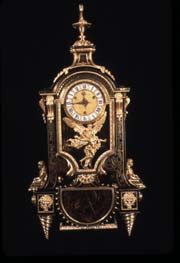
|
|
|
TELLING TIME/MEASURING WEATHER--Isaac Thuret's Barometer Clock at Frick
Collection. |
|
Almost like Count Dracula, he preferred the midnight hours. But he had his fifteen minutes of Andy Warhol-Style Fame when he appeared in Andy's film, The Thirteen Most Beautiful Boys of 1964.
But he earned a more durable and deserved fame for his expertise on French clocks, both as an author and consultant to Christie's, the Getty Museum, and even to the Frick Collection—to which he left his extremely discriminating and valuable collection.
In the current exhibition of clocks and watches now in the Frick's permanent collection are works by Abraham-Louis Breguet, Baltazar Martinot II, Isaac Thuret, Henry Arlaud, Edward East, Robert Robin, and Antoine Gaudron, among other masters.
Some ingenious clockworks are encased in handsome bodies created by the famed André-Charles Boulle.
These are displayed in the two basement galleries of the Frick Mansion. In the third floor vestibule of the Frick Art Reference Library, however, is a small case with some interesting examples of Edey's minuscule note-taking on watches and watch-making. Not to overlook tiny boxes of replacement parts for historic clockworks.
GUSTAV KLIMT/EGON SCHIELE
/OSKAR KOKOSCHKA:
From Art Nouveau to Expressionism
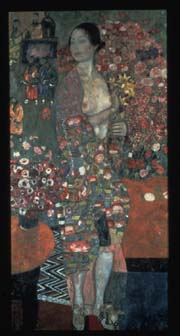
|
|
|
A KLIMT MOSAIC OF COLORS--This is "The Dancer" from the Neue
Galerie, not on view at Galerie St. Etienne which is also showing Klimts.
|
|
Only Blocks from the Neue Galerie
Now on View at Galerie St. Etienne
[Closing January 5, 2002]
This interesting installation makes a provocative pendant to the Austro-German Expressionists now on display at the new Neue Galerie. All three of Galerie St. Etienne's artists' works can also be seen in Ronald Lauder's new museum-gallery.
What is odd, however, is that there is no mention in the Neue Galerie's press-material of Galerie St. Etienne. And not only because they are both interested in the same areas, styles, movements, and artists.
But more importantly because Otto Kallir, founder of New York's Galerie St. Etienne, was also the founder of the original Neue Galerie in Vienna.
The very gallery which first inspired interest in Austrian and German Expressionism. And after which Lauder's gallery is named!
Actually, the current St. Etienne exhibit is more properly a pendant to a show now on view in Rome. This is a Klimt/Schiele/Kokoschka exhibition at the Museo del Vittoriano, curated by Jane Kallir of the St. Etienne.
Some of the Klimt outline sketches on paper now on display are rough studies for some important—and well-known—portraits. One can imagine, however, that Klimt would have wished they'd not been retrieved from his wastebasket. Or the back of his desk-drawer.
As for Egon Schiele, his obsession with the naked genitalia of young women is once again on parade here. His life was all too short and his creative output all too limited.
So we have to be thankful even for these examples of his undoubted talent. Still,—although Schiele genital studies as uncompromising as these are now displayed in major museums—Park Avenue gynecologists might think twice about hanging one of them in the waiting-room.
ETERNAL EGYPT:
Masterworks of Ancient Art
From the British Museum
Providing Vivid Visual Parallels
With Brooklyn Museum's Treasures

|
|
|
14] PHARAONIC PECTORAL--Middle Kingdom treasure from British Museum on view at Brooklyn Museum. |
|
But—although many New Yorkers do not know it—the Brooklyn Museum has in fact one of the finest collections of Middle Kingdom Egyptian artifacts outside of Egypt. Some of them are massive. As are some of the British loans.
According to the press-release: "Many of these objects have never before traveled outside of Great Britain." Considering the size and tremendous weight of some major pharaonic portrait statues, that's hardly surprising.
But they surely have traveled outside Britain before? They had to get to Britain from Egypt originally, after all.
And—if Islamism continues apace—Cairo Curators may soon be demanding their return from London.
Not to overlook Brooklyn's own treasures being forcibly returned to Luxor and Karnak… And the Louvre having to ship back all Napoleon stole from the Valley of the Kings. And Berlin being forced to return Nefertiti's lovely head!
What's especially valuable about the current loan show—in addition to the visual astonishments of individual portraits, designs, and hieroglyphics, large and small—is the range of the show.
Artifacts on view represent the entire Time-Line of the pharoahs: from the First Dynasty up to Cleopatra VII and the Roman Conquest.
There are a number of portraits and figures of courtiers which are, in their own ways, quite as interesting as noble images of great rulers.
Pharaonic names & their relics—such as Sesostris, Mentuhotep, Amenhotep, Thutmosis, Tutankhamun, Tiye, Akhenaten, Horemheb, Ramesses, and Ptolemy—are all on display. It is quite a Calvacade of Kings!
PREVIEWS OF COMING ATTRACTIONS:
VANISHING HISTORIES:
100 Endangered Sites from the World Monuments Watch
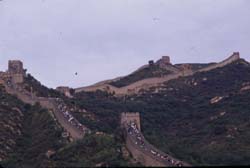
|
|
|
SAVE THE GREAT WALL
OF CHINA!--One of the World's 100 Most Endangered Sites—and it is
so long! Photo: ©GLENN LONEY/INFOTOGRAPHY 2001 |
|
These are always at risk—not only from the hazards of war and the predations of unscrupulous art-dealers—but also from Nature herself. Earthquakes, erosion, and the elements all attack such cultural treasures.
In January, the World Monuments Fund is leading two tours to Cambodia's fabled temples of Angkor Wat. It is involved in restoration and preservation projects there.
Every year, it issues a list of endangered sites which need patrons and protection. And they aren't all in Third World countries.
How about our own St. Ann's & Holy Trinity Church in Brooklyn Heights? Or Mission San Juan Capistrano in California?
The Fund's Gallery—at 95 Madison Avenue/9th floor—will focus attention on some of the more pressing current projects or imperiled sites.
This special exhibition will feature a selection of powerful color photos from the book of the same title, published by Harry N. Abrams.
As a supporter of the Fund, I find I have already visited a number of the sites or structures in danger: among them Theresienstadt/Terezin Fortress, Luxor, Edfu, Beauvais Cathedral, Heidelberg's Carl-Theodore Brücke, Petra, Benin City, Selby Abbey, and The Great Wall of China—and there is a lot of it!
BASEBALL AS AMERICA—

|
|
|
JACKIE ROBINSON'S
DODGERS SHIRT--Coming to American Museum of Natural History from Cooperstown
Baseball Hall of Fame. Photo: ©Raffi Van Chromes/2001. |
|
At American Museum of Natural History
[Opening March 16/Closing August 18, 2002] With the resurgence of Passionate Patriotism which has resulted from the tragedy of the World Trade Center attack, flags were flying and hands held over hearts at the American Museum of Natural History for the press-preview of a sure-to-be Blockbuster Show opening this Spring.An All-Star Cast of Baseball Greats was on hand to celebrate the launch of a nation-wide tour of artifacts from the History of American Baseball preserved in the National Baseball Hall of Fame & Museum in Cooperstown, in upstate New York.
This is the first time these treasures have left the Hall of Fame's hallowed halls on tour. As an advance example of what will be on view in March, the Ebbett's Field Cornerstone [Brooklyn Dodgers] is now prominently displayed at the museum. Along with some vintage seats from the mythic Polo Grounds [New York Giants].
The unfortunate fact that both the Dodgers [LA] and the Giants [SF] fled New York for California is of course also part of the history of the sport which will be noted in the forthcoming show.
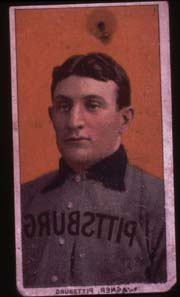
|
|
|
COLLECTOR'S ITEM--Honus
Wagner Baseball Card. Photo: ©Raffi Van Chromes/2001 |
|
The Baseball Hall of Fame has no less than 35,000 artifacts and 2.6 million documents in its museum collections. The pick of these will be on view, not only in Manhattan, but also at nine leading American museums around the nation during this extended tour.
The press-launch was accompanied not only by rousing patriotic songs—and the original lyrics of "Take Me Out to the Ballgame!"—but also with popcorn, hot-dogs, sauerkraut, and Crackerjack!
For those non-populist scientific skeptics who may have wondered how such a show could be justified in the even more hallowed halls of the Natural History Museum than in Cooperstown, Museum President Ellen Futter had a ready answer.
Just as whole sections of the museum are devoted to the cultural ethnography of various peoples throughout the world, so also is the study of American Ethnography a valid area of investigation at the museum.
You can perhaps imagine teams of student archaeologists digging around the perimeters of Yankee Stadium, hoping to find some long lost fly-balls? Or ethnological chemists analyzing the traces of perspiration left in Babe Ruth's old uniform? Did he ever have flop-sweat?

|
|
|
MATISSE/PICASSO
PAIRED--MoMA will show Pablo Picasso's "Three Dancers" beside
a Matisse Masterpiece. |
|
MATISSE PICASSO—
At the New Museum Venue: MoMA QNS
[Opening February 13/Closing May 20, 2003] Note that the opening date of the first major show the Museum of Modern Art will be mounting in its new Queens quarters is over a year away. Not just a month or two.Extensive reconformation of the old Swingline Stapler Factory is moving along rapidly, but it won't be open to the public as MoMA QNS until June/July 2002.
By that time, the famed quasi-Bauhaus West 53rd Street building will have been closed for the creation of a new MoMA on the extended site. But the Modernist facades on West 53rd will be preserved.
Until the launch of the major Matisse/Picasso show, works from MoMA's permanent collections and smaller-scale shows will be mounted in Queens. Take subway line #7 from Times Square or Grand Central to Long Island City and detrain at the 33rd Street Station in Queens.

|
|
|
MATISSE/PICASSO
PAIRED--Pierre Matisse's "Nasturtiums with 'Dance'" will parallel
Picasso's painting. |
|
Matisse Picasso will be the only US showing of this seminal pairing of "the two greatest artists of the 20th century." This judgment is not only that of the show's curators, but, apparently, of the two artists themselves.
Despite claims of some critics that the two men were often opposing forces in modern art, this show—through its magisterial pairings of works of similar subjects and styles—will demonstrate how close they were in both life and work throughout their careers.
This major exhibition is a MoMA collaboration with the Tate Modern in London and three Paris institutions: the Centre Pompidou, the National Museum of Modern Art, and, of course, the Musée Picasso.
[Loney]
Copyright © Glenn Loney 2000. No re-publication or broadcast use without proper credit of authorship. Suggested credit line: "Glenn Loney, Curator's Choice." Reproduction rights please contact: jslaff@nymuseums.com.